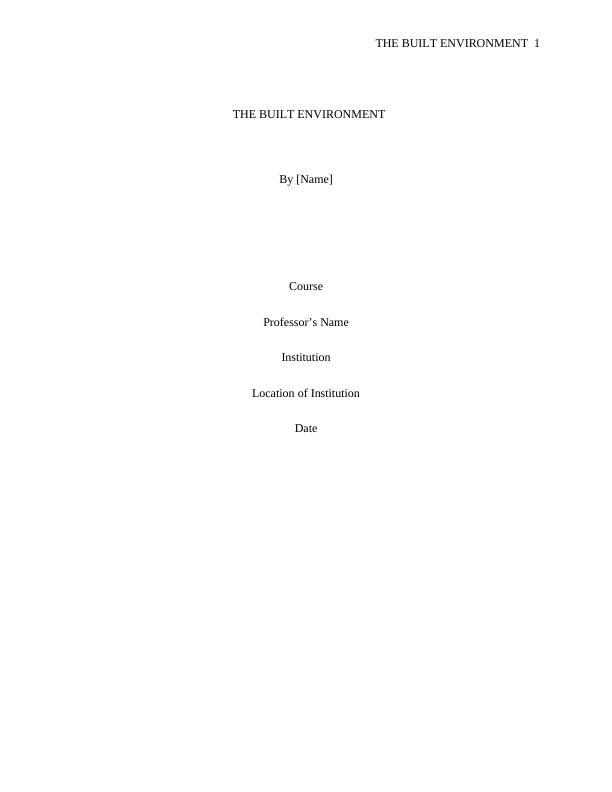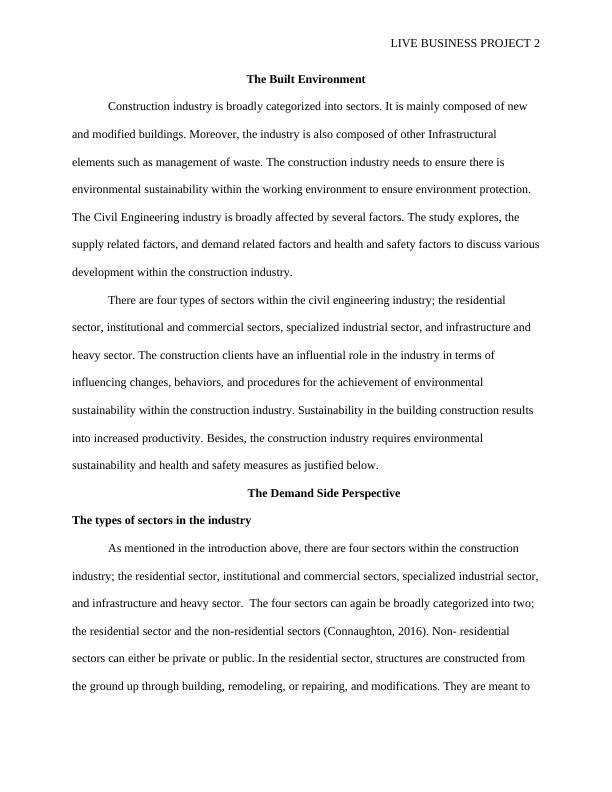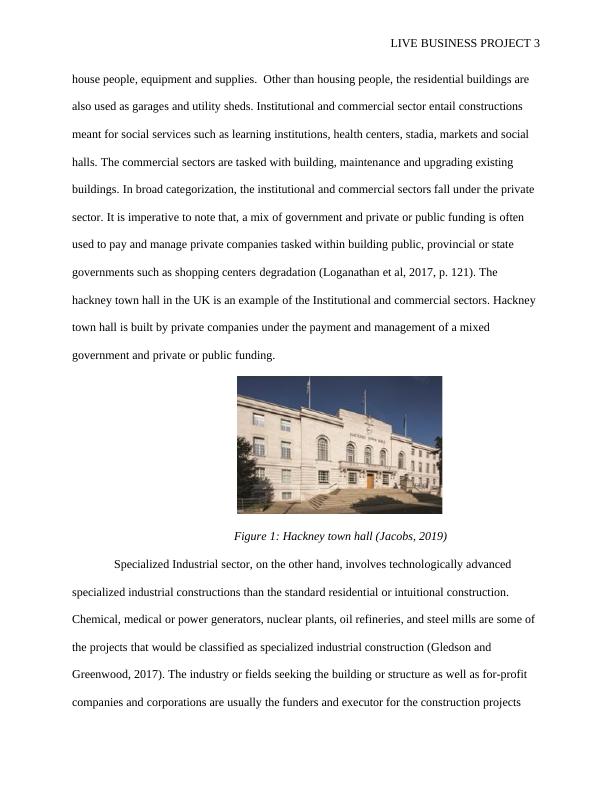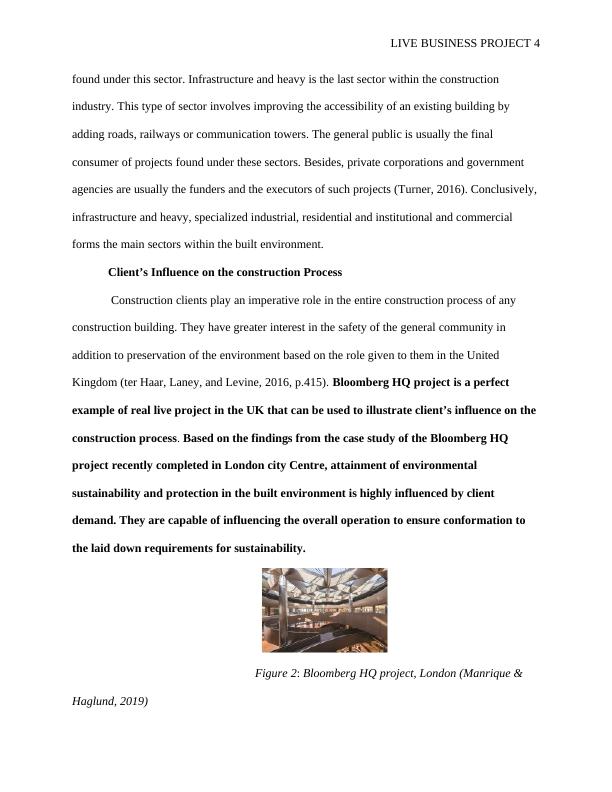The Built Environment
Added on 2022-08-21
13 Pages3384 Words16 Views
THE BUILT ENVIRONMENT 1
THE BUILT ENVIRONMENT
By [Name]
Course
Professor’s Name
Institution
Location of Institution
Date
THE BUILT ENVIRONMENT
By [Name]
Course
Professor’s Name
Institution
Location of Institution
Date

LIVE BUSINESS PROJECT 2
The Built Environment
Construction industry is broadly categorized into sectors. It is mainly composed of new
and modified buildings. Moreover, the industry is also composed of other Infrastructural
elements such as management of waste. The construction industry needs to ensure there is
environmental sustainability within the working environment to ensure environment protection.
The Civil Engineering industry is broadly affected by several factors. The study explores, the
supply related factors, and demand related factors and health and safety factors to discuss various
development within the construction industry.
There are four types of sectors within the civil engineering industry; the residential
sector, institutional and commercial sectors, specialized industrial sector, and infrastructure and
heavy sector. The construction clients have an influential role in the industry in terms of
influencing changes, behaviors, and procedures for the achievement of environmental
sustainability within the construction industry. Sustainability in the building construction results
into increased productivity. Besides, the construction industry requires environmental
sustainability and health and safety measures as justified below.
The Demand Side Perspective
The types of sectors in the industry
As mentioned in the introduction above, there are four sectors within the construction
industry; the residential sector, institutional and commercial sectors, specialized industrial sector,
and infrastructure and heavy sector. The four sectors can again be broadly categorized into two;
the residential sector and the non-residential sectors (Connaughton, 2016). Non- residential
sectors can either be private or public. In the residential sector, structures are constructed from
the ground up through building, remodeling, or repairing, and modifications. They are meant to
The Built Environment
Construction industry is broadly categorized into sectors. It is mainly composed of new
and modified buildings. Moreover, the industry is also composed of other Infrastructural
elements such as management of waste. The construction industry needs to ensure there is
environmental sustainability within the working environment to ensure environment protection.
The Civil Engineering industry is broadly affected by several factors. The study explores, the
supply related factors, and demand related factors and health and safety factors to discuss various
development within the construction industry.
There are four types of sectors within the civil engineering industry; the residential
sector, institutional and commercial sectors, specialized industrial sector, and infrastructure and
heavy sector. The construction clients have an influential role in the industry in terms of
influencing changes, behaviors, and procedures for the achievement of environmental
sustainability within the construction industry. Sustainability in the building construction results
into increased productivity. Besides, the construction industry requires environmental
sustainability and health and safety measures as justified below.
The Demand Side Perspective
The types of sectors in the industry
As mentioned in the introduction above, there are four sectors within the construction
industry; the residential sector, institutional and commercial sectors, specialized industrial sector,
and infrastructure and heavy sector. The four sectors can again be broadly categorized into two;
the residential sector and the non-residential sectors (Connaughton, 2016). Non- residential
sectors can either be private or public. In the residential sector, structures are constructed from
the ground up through building, remodeling, or repairing, and modifications. They are meant to

LIVE BUSINESS PROJECT 3
house people, equipment and supplies. Other than housing people, the residential buildings are
also used as garages and utility sheds. Institutional and commercial sector entail constructions
meant for social services such as learning institutions, health centers, stadia, markets and social
halls. The commercial sectors are tasked with building, maintenance and upgrading existing
buildings. In broad categorization, the institutional and commercial sectors fall under the private
sector. It is imperative to note that, a mix of government and private or public funding is often
used to pay and manage private companies tasked within building public, provincial or state
governments such as shopping centers degradation (Loganathan et al, 2017, p. 121). The
hackney town hall in the UK is an example of the Institutional and commercial sectors. Hackney
town hall is built by private companies under the payment and management of a mixed
government and private or public funding.
Figure 1: Hackney town hall (Jacobs, 2019)
Specialized Industrial sector, on the other hand, involves technologically advanced
specialized industrial constructions than the standard residential or intuitional construction.
Chemical, medical or power generators, nuclear plants, oil refineries, and steel mills are some of
the projects that would be classified as specialized industrial construction (Gledson and
Greenwood, 2017). The industry or fields seeking the building or structure as well as for-profit
companies and corporations are usually the funders and executor for the construction projects
house people, equipment and supplies. Other than housing people, the residential buildings are
also used as garages and utility sheds. Institutional and commercial sector entail constructions
meant for social services such as learning institutions, health centers, stadia, markets and social
halls. The commercial sectors are tasked with building, maintenance and upgrading existing
buildings. In broad categorization, the institutional and commercial sectors fall under the private
sector. It is imperative to note that, a mix of government and private or public funding is often
used to pay and manage private companies tasked within building public, provincial or state
governments such as shopping centers degradation (Loganathan et al, 2017, p. 121). The
hackney town hall in the UK is an example of the Institutional and commercial sectors. Hackney
town hall is built by private companies under the payment and management of a mixed
government and private or public funding.
Figure 1: Hackney town hall (Jacobs, 2019)
Specialized Industrial sector, on the other hand, involves technologically advanced
specialized industrial constructions than the standard residential or intuitional construction.
Chemical, medical or power generators, nuclear plants, oil refineries, and steel mills are some of
the projects that would be classified as specialized industrial construction (Gledson and
Greenwood, 2017). The industry or fields seeking the building or structure as well as for-profit
companies and corporations are usually the funders and executor for the construction projects

LIVE BUSINESS PROJECT 4
found under this sector. Infrastructure and heavy is the last sector within the construction
industry. This type of sector involves improving the accessibility of an existing building by
adding roads, railways or communication towers. The general public is usually the final
consumer of projects found under these sectors. Besides, private corporations and government
agencies are usually the funders and the executors of such projects (Turner, 2016). Conclusively,
infrastructure and heavy, specialized industrial, residential and institutional and commercial
forms the main sectors within the built environment.
Client’s Influence on the construction Process
Construction clients play an imperative role in the entire construction process of any
construction building. They have greater interest in the safety of the general community in
addition to preservation of the environment based on the role given to them in the United
Kingdom (ter Haar, Laney, and Levine, 2016, p.415). Bloomberg HQ project is a perfect
example of real live project in the UK that can be used to illustrate client’s influence on the
construction process. Based on the findings from the case study of the Bloomberg HQ
project recently completed in London city Centre, attainment of environmental
sustainability and protection in the built environment is highly influenced by client
demand. They are capable of influencing the overall operation to ensure conformation to
the laid down requirements for sustainability.
Figure 2: Bloomberg HQ project, London (Manrique &
Haglund, 2019)
found under this sector. Infrastructure and heavy is the last sector within the construction
industry. This type of sector involves improving the accessibility of an existing building by
adding roads, railways or communication towers. The general public is usually the final
consumer of projects found under these sectors. Besides, private corporations and government
agencies are usually the funders and the executors of such projects (Turner, 2016). Conclusively,
infrastructure and heavy, specialized industrial, residential and institutional and commercial
forms the main sectors within the built environment.
Client’s Influence on the construction Process
Construction clients play an imperative role in the entire construction process of any
construction building. They have greater interest in the safety of the general community in
addition to preservation of the environment based on the role given to them in the United
Kingdom (ter Haar, Laney, and Levine, 2016, p.415). Bloomberg HQ project is a perfect
example of real live project in the UK that can be used to illustrate client’s influence on the
construction process. Based on the findings from the case study of the Bloomberg HQ
project recently completed in London city Centre, attainment of environmental
sustainability and protection in the built environment is highly influenced by client
demand. They are capable of influencing the overall operation to ensure conformation to
the laid down requirements for sustainability.
Figure 2: Bloomberg HQ project, London (Manrique &
Haglund, 2019)

End of preview
Want to access all the pages? Upload your documents or become a member.
Related Documents
Introduction to the Built Environment and Construction Managementlg...
|9
|3519
|118
Introduction to the Built Environment and Construction Managementlg...
|14
|3792
|270
Sustainable Urban Development: A Literature Reviewlg...
|14
|4263
|41
CSM80002 Environmental Sustainabilitylg...
|5
|1619
|63
